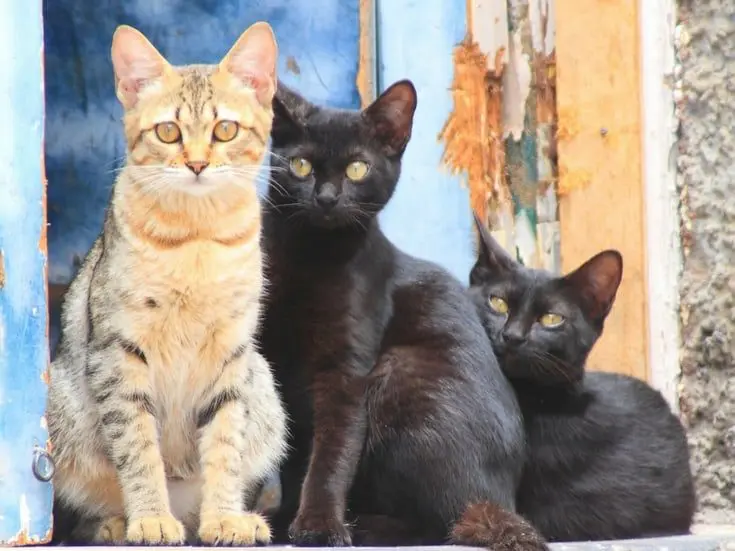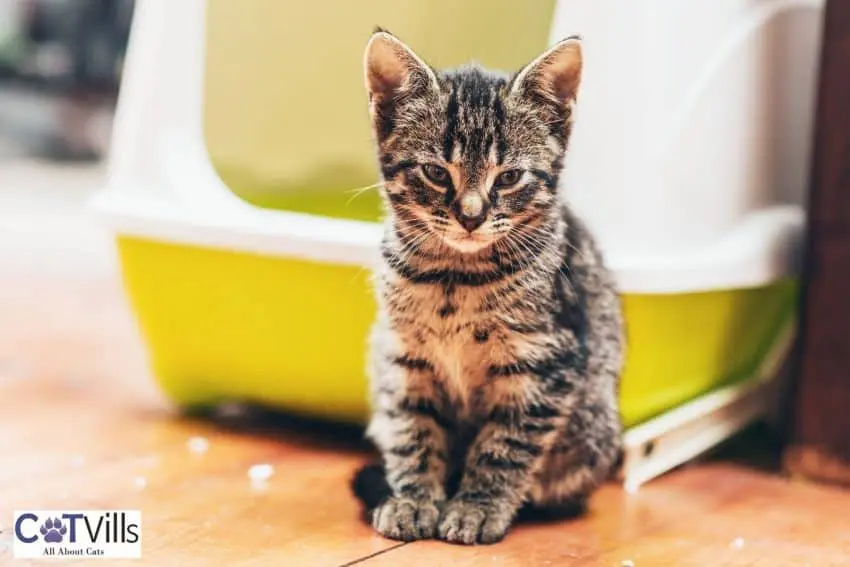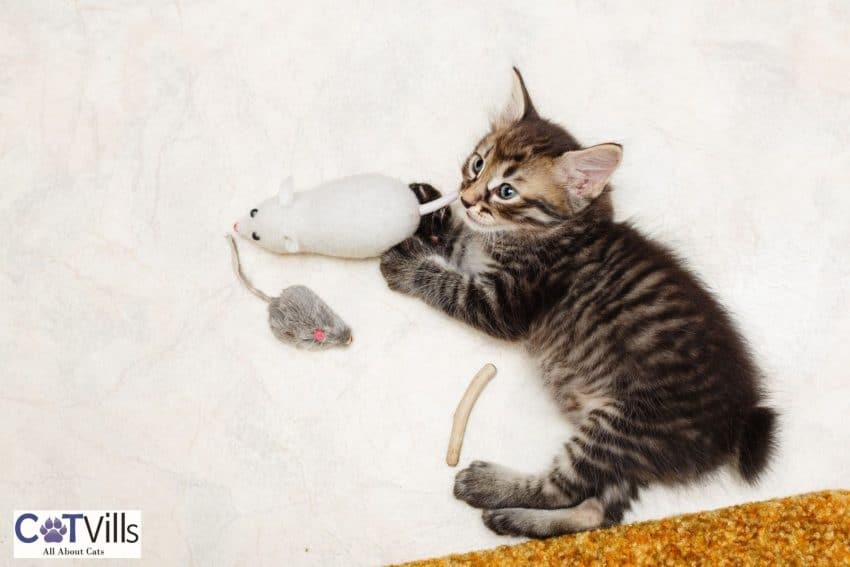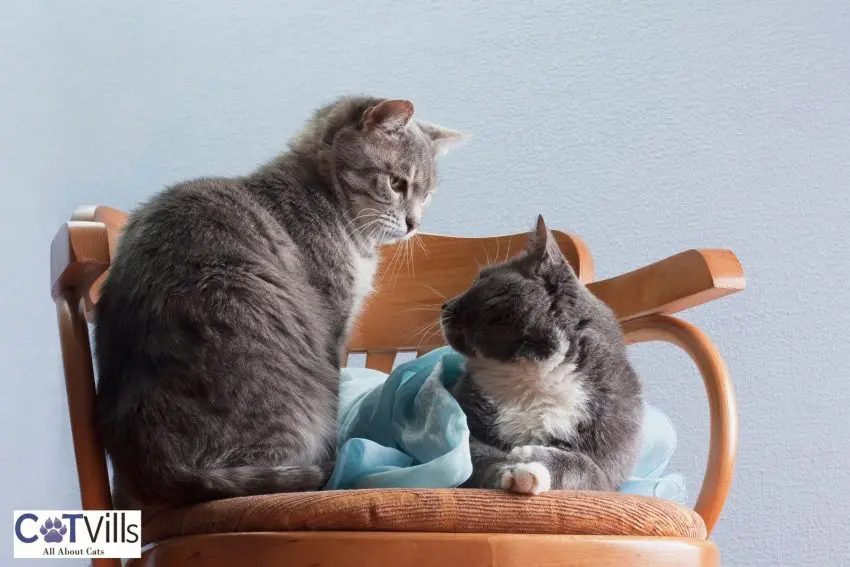Last Updated: 4 months ago
Wondering what to expect when you add a third cat to your household?
It’s a big decision to add to your family, even if that addition is a fur baby instead of a human one.
For starters, you need to be prepared for the additional expenses of litter and food, of course.
But should you be worried about differences you’d see in your relationship with other cats?
TIPS FOR INTRODUCING A THIRD CAT TO THE MIX

First, you need to consider your current cats’ temperament. Are they relatively easy-going? If so, adding a third cat may work well.
In fact, there may even be benefits of getting a third cat.
For example, adding a kitten can help rejuvenate your older cats’ energy and desire to play.
Also, consider how your current cats got to know each other.
Did you have one and introduced the other, or did you get them at the same time?
If your two cats have only ever known life as a pair, introducing a third could be a bit trickier, but it’s still doable.
1. Introduce a kitten

When you’re choosing a third cat, try to go with a kitten. Most cats will respond more favorably to a kitten than they will a grown cat.
If you have your heart set on three cats, look to adopt a kitten that your adult cats can “take under their wing.”
Pay attention to the kitten’s personality, too. If you can see that the kitten is feisty, easily startled, or hisses frequently, move on.
The more laid-back your new cat is, the more your current cats will accept him.
As far as 3rd cat gender goes, it really depends on whether your cats are fixed or intact.
For example, if you’re unable to spay your female cat for some reason, you don’t want to add an intact male cat to the mix!
If all of the cats are fixed, you shouldn’t notice any issues with bringing a male “girl territory” or vice-versa.
2. Start slow
Many cats don’t deal too well with change.
They like familiarity in their surroundings, and even the slightest upset can cause an otherwise well-behaved cat to adopt naughty behaviors like marking. Keep the new cat separated from your other cats at first.
He should have his own litter, food, and bed in a room full segregated from the others. They’ll know he’s there, and they can start getting used to the idea of another cat in their midst.
Keep the cats apart for at least a few days, if not a week.
3. Food unites

Start introducing the cats during mealtime.
- Put the new cat’s food dish near the doorway of his enclosed room, and the other cat’s dishes on the other side of the door (with the door closed).
- The next day, open the door and see how it goes.
- If either cat tries to eat food other than his own, close the door again.
- Keep trying with mealtime until the cats respond well.
4. Exchange rooms or bedding
Now that your current cats have become familiar with another cat in the house, it’s time to help the new cat get used to the idea of other cats.
Exchange their bedding for a night or swap rooms – let your new cat wander the house and soak in the other cats’ smells while your current cats are stowed away elsewhere.
5. Provide small sessions of supervised visitation

Provide toys in one room and allow the cats to spend 15-20 minutes together in the same room with you present.
Praise the cats both verbally and with petting when they behave favorably toward others.
If any of the cats begin growling or show signs of aggression, end playtime and separate the cats again. Try again tomorrow.
6. Increase their time together
As the cats tolerate time together, slowly increase the amount of time and decrease your supervision.
Be careful and listen for hissing, growling, or yowling if you are not in the room with the cats.
Immediately separate them if necessary. Over time, the cats will likely learn to co-exist, even if they don’t end up becoming friends.
7. Make sure they get along before leaving them alone

Be sure your cats are capable of co-existing peacefully before leaving them alone together.
Do not leave the house without separating the cats until you are absolutely sure that they can co-exist peacefully.
It’s better to be safe than sorry!
8. Respect each cat’s desire for time with you
Make sure you spend time separately with each cat to minimize their negative feelings about their new situation.
Although some people may say cats don’t have an affinity toward their humans, most cat owners would disagree! Continue to show each cat that he or she is special to you in his or her own way.
9. Know when to call it quits

If after a month or so, you still see the cats acting aggressively toward each other, it’s unlikely that they will learn how to live in the same house.
Unfortunately, it may be time to start looking for a new home for the new cat.
In most cases, cats can be taught how to live nicely together.
It is important that you have the time to put into properly introducing them and ensuring that they get along before leaving them to fend for themselves.
If you’re not sure this is realistic for you, it may be best to leave your family as it is and consider adding a third cat later on.
Is two or three cats better? Only you can decide that! If you do opt for kitty #3, just follow our tips for introducing everyone and it should be just fine!


Dr. Linda Simon MVB MRCVS is a locum veterinary surgeon who has worked in London for the past 8 years. She graduated top of her class in small animal medicine from UCD, Dublin. She is currently a member of the Royal College of Veterinary Surgeons. Linda is the resident vet for Woman magazine and a frequent contributor to People’s Friend Magazine, the Dogzone website, Vet Help Direct and Wag! Linda also writes content for the CVS veterinary group, Vetwriter and a number of other establishments.
